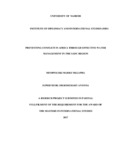| dc.description.abstract | Preventing the outbreak of destructive conflict remains one of the most difficult challenges in the 21st Century. In the case of this study, water conflicts are seen as being inevitable if nothing is done to prevent them from occurring. Competition for the available water resources will continue to increase to a point where new and perhaps radically different interventions are needed.
In the SADC region, the most shared of natural resources is that of water and which occurs with varying abundance or scarcity at different times of the year in different parts of the region. The objectives of the study are: To identify challenges faced by states over transboundary water shared resources with a focus on SADC. To assess the effectiveness of policies or agreements in preventing conflicts over shared water resources with a focus on SADC. To recommend ways of enhancing prevention of conflicts over shared water resources with a focus on SADC. The data collection methods involved secondary data obtained from the published and unpublished books and project reports, magazines, and journals on conflict prevention, water management, water resources, physical and hydrological aspects of the selected shared rivers, agreements now in operation and institutions established for selected international river basins, water resources developments as well as sectoral water use. This study has concluded that unlike domestic conflicts over water quantity and quality, which are generally accessible to resolution by a higher-level state authority or by informal means, i.e. by the users themselves, one particular feature of transboundary water-use conflicts is that they can be resolved only though negotiations between sovereign states. Despite limited number of formal coordination forums, transboundary water management has made considerable progress, especially in Southern Africa: New organizations have been founded, older organizations restructured and leaned own, and some such organizations have enlarged their regulatory scopes and fields of responsibility and redefined their functions. The reasons for this must be sought in the overall political constellation given at present, with the Republic of South Africa, the dominant regional power, pursuing a cooperative and pro-integration course. Furthermore, the Southern African Development Community (SADC) provides an overarching political framework conducive to such efforts aimed at transboundary cooperation. Another important success factor must be seen in the instrumentalist, pragmatic approach that has been pursued in the development of trans boundary water organizations; two features typical of the approach are confidence-building measures and the procedures governing of intergovernmental cooperation that have now been established | en_US |



